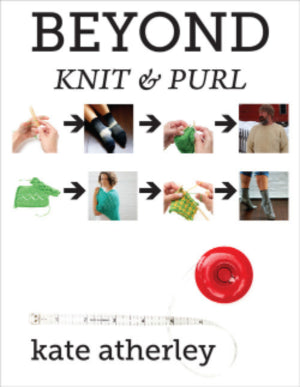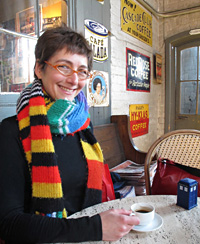I make no secret of the fact that I get cranky about poorly written knitting patterns - as a designer and tech editor, it feels like an opportunity missed. A weak pattern leads to frustrated knitters, and frustrated knitters become non-knitters.
Now, none of this is to say that I expect every designer to be a great pattern writer. Designing and writing patterns are different skills - and that's ok! I would rather that the incredibly creative genius designer types focus their time and skills on that!
It's all about division of labour: leave the creativity and designing to the designers, leave the pattern writing to the pattern writers. If you're a designer, get a tech editor to help you with your pattern!
At Sock Summit, I'm teaching a class on how to write up a good sock pattern, and I want to pass along as many suggestions as possible for what to do (and what not to do).
To help me with that, a little survey for you, my dear readers: what drives you insane in patterns? What do you wish was better explained? What frustrates you?
Let me know, so I can do my bit to help educate pattern writers - and become a better tech editor, too.
Leave comments or drop me an email. Thank you!
Subscribe to:
Post Comments (Atom)






14 comments:
Although this does not apply to sock patterns, I loathe the "now do the left side as the right but REVERSED" set of directions. I know how to do this but it completely takes your mind out of the knitting zone. It's like following a detour. Not impassible but I'm not taking that road again!
As for socks. I love Evelyn A. Clark sock patterns. I can't put my finger on what is different (I think it's how she twists stitches when picking up the sides of the flap) but her directions are easy, smooth to follow and you can tell right away that you are following the directions correctly. That last part is the most important part!
Lastly, I recently ran into a pattern problem and emailed the designer. She got right back to me, explained the line of directions (publisher had changed her description of which chart to use) and has checked into my ravelry page to see if it worked. Communication is a great solution to many hurt feelings.
Enjoy your class - I only wish I could be there.
I really appreciate when designers tell you specifically what cast on and bind off methods they used.
Also, finishing techniques are a big one. I find more often than not you are left to your own devices. With varying results!
I also don't like the "reverse shaping" direction. I can DO it - I know how to - but sometimes, I'm knitting when I'm tired, and I find it harder to concentrate and figure the whole thing out. (I often write out ahead of time what I have to do).
With socks, when the pattern is for sale - especially online - I like to know if it's toe up or top down and what the heel treatment is. The "auto heel" or heel-like-a-commerical-sock-heel fits me poorly, and while in some cases you can sub in a heel flap and traditional turned heel, some designs are disrupted by that method.
I have a sweater pattern I'd love to do but it says something like, "Because the two stitch patterns have varying row gauges, you will need to work a short-row every 20th row" but they don't specify exactly how that's done nor are they totally clear about WHICH stitch pattern you're working the short-rows in.
Yup, specify the cast-ons and bind-offs, and WHY they're appropriate.
Also, a brief note about yarn choice is helpful, especially when samples are done up with indie dyers' lovely goods -- if I can't get my hands on the original (or just want to sub something else) it's helpful to know what's most important in the yarn for a specific pattern. Is it bouncy? drapey? fuzzy? chain-plied?
What can I say, I guess I like to learn!
I, too, hate it when the pattern tells you to "reverse the shaping" for the second half.
I always appreciate patterns that are very specific about cast-on and bind-off.
My favorite touch is when a pattern includes "bench notes" up front, such as pointing out that three sets of things will be happening simultaneously when you shape the gusset, or mentioning that the stitch count changes within the lace pattern.
I also hate it when a pattern claims to have 3 or 4 sizes, but those are actually just achieved by changing the gauge. I don't WANT a loose gauge for my socks! That trick works better for things that don't get hard wear, like mittens or mitts.
I hate it when the stitch pattern changes and at the end of the row it doesn't state how many stitches you should have in total--this means that you don't realize that you've made a mistake until the next row when things don't make sense and then you've got two rows to rip out or correct.
Also, I like charted patterns so those knitting patterns that don't include charts cause confusion with all the commas and wording.
All of the above!
I've only been knitting properly for 6 months and find that some designers assume too much - because they have lots of experience and know what to do, they assume others do, too.
I'm with AnniebeeKnits. I like to know more about the yarn. Unless you're writing for a yarn company, tell me about some alternatives. The sock pattern I'm using now uses a yarn with some elastic in it. What do you make of yarn that says "186yds/167m stretched. 100yds/90m relaxed"? What is the stitch guage referring to? How do I even begin to choose a needle size? Even if I were using the same yarn this would still be confusing! I've already frogged three inches to start again. I'll see.
And, while I've been knitting for more than forty years, I'm not "prolific" or "passionate" about it. There's a lot I don't know. Don't make assumptions about what I do or don't know. I consider myself a moderately experienced knitter and while I have been known (that would be a *very* past tense) to do some pretty complex things, I don't really want to spend an hour on the internet learning new techniques or brushing up on old ones when the pattern could just as well include them.
Thanks for listening!
All of the above especially not giving the stitch count after decrease / increases - I can forgive it in a free pattern but definitely not in a pattern I've paid for.
Although this complaint is not about socks - this note from a simple lace sweater pattern has me stalled on this 1/2 finished sweater for the past 2 summers: Within the lace pattern, each (yo) is paired with a dec. When increasing or decreasing at the edge of work (eg neckline/armholes, be sure to keep lace pattern correct. do not work a (yo) if there are not enough sts to work its accompanying decrease.
I've usually ended up with large sections of knit or the stitch count is way off - any info would be great!
Enjoy the Sock Summit -
All of the above! I also would love to see more information than just Dec or Inc. Which way did the designer use and why. Other thing that really bugs me: when tension/gauge is stated as x sts and rows in pattern rather than in stockinette stitch. Makes it very difficult to substitute yarns because you aren't comparing apples to apples. Then if the pattern is from a yarn company they obviously don't want you to substitute! Still they do often discontinue yarns or you may have the pattern as part of your pattern stash and decide to knit it long after the yarn is no longer available. Just love too that yarn manufacturers who write patterns cover their butts with statements like how important it is to check your tension/gauge and how they are NOT responsible for your results if you do use other yarn!! So does that mean they are responsible if I do use their yarns and am not happy with the results??? I sincerely doubt it!!
One thing that bothers me is when there aren't good pictures with a pattern. I don't need to see socks balancing on a log in a swamp with an alligator in the background. I need to see them up close to really see the stitch pattern, and I need a well-focused picture of the entire sock, preferably in a solid or semisolid yarn. Photos make a tremendous difference!
I like to see the stitch gauge given in both stockinette stitch, AND any pattern stitches. It makes it easier to choose a different yarn. I get fustrated by patterns without the basics...gauge, yarn details, etc. Or, it says 2oz of worsted weight yarn. NOT helpful! Or too general of sizing..."medium" instead of finished measurement. I also like reading if it should have positive or negative ease, that really helps...
Ooh! I hate patterns that aren't properly test knit, so when I've paid $8.00 for the pleasure of knitting a pattern, I find that I cannot make it do what the picture demonstrates. That makes me bonkers.
I get that there are some errors, but glaring mistakes like, oh, "five rows" where the designer means "five inches" is something that really should have come out in the test knitting.
Readability of the pattern drives me crazy! For example, I love it when informational items in the row directions are marked. It makes it much easier to find/glance at the correct row to compare with the chart or verify a direction. So many times I have to stop knitting to figure out what part of the row direction pertains to my question. Example:
R21: k29, [Chart B: R21: (ktbl, p1) 3 times ktbl, yo, k4, yo,
k2tog, k3, yo, (ktbl, p1) 3 times ktbl], k28
This would be easier to read if R21 were bolded, and Chart B were italized since both are for information.
Along with the type of cast on/off, I'd like to know if short rows are W&T or not. I knit a project where it was not specified, and thanks to Ravelry, I was able to get an answer from the designer.
Also, I really like it when the directions and the associated chart are at least on facing pages; much easier to compare written to charted directions on my computer.
It would be nice if pages of the pdf file that need to be in landscape orientation are planned that way so that all notes are also landscape. I know I can re-rotate the page on my computer, move my head, or just turn the physical page, but it would be easier if I didn't have to.
Thanks for the opportunity to voice my opinion; wish I could go to your class!!
sandygale (Ravelry)
Post a Comment